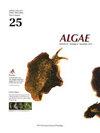南极南奥克尼群岛蓝细菌属Wilmottia的首次记录
IF 2.4
3区 生物学
Q1 MARINE & FRESHWATER BIOLOGY
引用次数: 4
摘要
采用形态学、细胞学和分子分析相结合的多相方法,对从南极洲南奥克尼群岛Signy岛分离的两种蓝藻形态进行了表征。这些分析表明,这些菌株属于威尔莫特属。该属有三个物种,即毛茛属(W.murrayi)、严格毛茛(W.stricta)和可丽花属(W.koreana)。在这项研究中分析的两种形态类型都属于穆拉伊的分支。该分支显示出与南极洲和新西兰菌株以及其他地区菌株的良好分离。W.murrayi最早在南极洲被描述,现在在几个南极地区被发现。在Signy岛确认了W.murrayi的出现,极大地扩展了其在南极洲的已知分布。此外,文中还提出了一个新的组合,即石楠。本文章由计算机程序翻译,如有差异,请以英文原文为准。
First record of the cyanobacterial genus Wilmottia (Coleofasciculaceae, Oscillatoriales) from the South Orkney Islands (Antarctica)
Two cyanobacterial morphotypes isolated from Signy Island, South Orkney Islands, maritime Antarctica were char-acterised using a polyphasic approach combining morphological, cytological and molecular analyses. These analyses showed that the strains grouped with members of the genus Wilmottia . This genus has three species, W. murrayi , W. stricta , and W. koreana . Both morphotypes analysed in this study were placed within the clade of W. murrayi . This clade showed a well-supported separation from Antarctica and New Zealand strains, as well as the strains from other regions. W. murrayi was first described from Antarctica and is now known from several Antarctic regions. Confirmation of the occurrence of W. murrayi at Signy Island significantly extends its known distribution in Antarctica. In addition, a new combination, W. arthurensis , is suggested for Phormidium arthurensis .
求助全文
通过发布文献求助,成功后即可免费获取论文全文。
去求助
来源期刊

Algae
PLANT SCIENCES-
CiteScore
5.10
自引率
25.00%
发文量
18
期刊介绍:
ALGAE is published by the Korean Society of Phycology and provides prompt publication of original works on phycology. ALGAE publishes articles on all aspects of phylogenetics and taxonomy, ecology and population biology, physiology and biochemistry, cell and molecular biology, and biotechnology and applied phycology. Checklists or equivalent manu-scripts may be considered for publication only if they contribute original information on taxonomy (e.g., new combinations), ecology or biogeography of more than just local relevance. Contributions may take the form of Original Research Articles, Research Notes, Review Articles and Book Reviews.
 求助内容:
求助内容: 应助结果提醒方式:
应助结果提醒方式:


